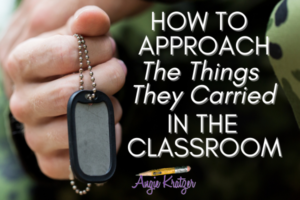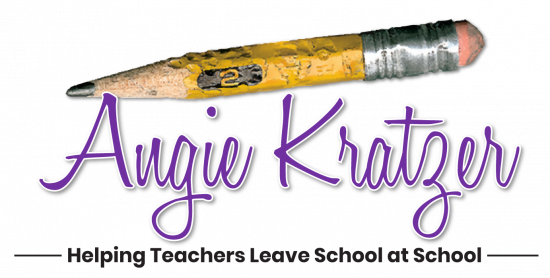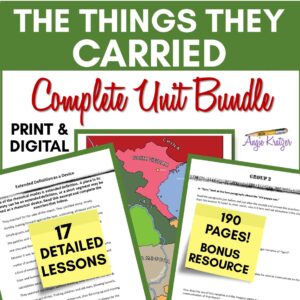Yes. Yes to all of that.
There are so many ways to approach Tim O’Brien’s The Things They Carried within secondary lesson plans. I’ve tried two.
Approach 1 for a quick treatment of The Things They Carried
Students plow through the whole book outside of class (in my case as summer reading) because it’s high interest enough to avoid too much resistance. Students have a deadline, take a did-you-read-it assessment just for accountability, and we dive in to the analysis of some select passages and wrestle with the themes and theses of the work as a whole. The advantage to this approach is that we don’t beat the book to death. One disadvantage is that students are on their own through a pretty harrowing narrative. Another is that we walk right by a diamond mine of material via which we could be teaching a whole host of skills. I like diamonds, so I lean now toward a more thorough treatment.

Approach 2 for a deep dive into Tim O’Brien’s themes
Assign the reading in chapter chunks, most of which are completed outside of class with one or two in-class silent reading days sprinkled in. Spend one to four days on each chapter set and do it right: address one specific rhetorical mode by learning to write in it and about it as a strategy and as a device. Look at character, symbolism, and theme like it’s a work of fiction and apply a non-fiction lens to the same work and look at O’Brien’s rhetoric. A teacher on a block schedule might use this work as her one “novel” of the semester.
I’ve developed–in excruciating detail–mini units for eight chapter sets and bundled them all together in this complete unit for The Things They Carried. Here’s how I built it:
Background and Chapter 1 Lesson Plans (“The Things They Carried”):
Contents: This 34-page unit contains five lesson plans (60-120 minutes each), eleven handouts, one reading quiz, and four versions of a map of Southeast Asia. Materials focus on student understanding of the Vietnam conflict, analysis of symbolism, and writing and analysis of essays in the definition mode. Contents: Lesson 1: Building Background Knowledge Vietnam War Timeline Student Handout A: Map of Vietnam Conflict (several versions) Student Handout B: Soldier Lingo Scavenger Hunt (and key) Student Handout C: Windshield Bugs Ticket Out the Door Student Handout D: The Things They Carried (organizer) Lesson 2: Symbolism Analysis Reading Quiz on Chapter 1 Student Handout D key (an exhaustive list of the things the men carry) Student Handout E: Analyzing Symbolism Lesson 3: The Extended Definition Mode Student Handout F: The Extended Definition Lesson 4: Extended Definition as a Device Student Handouts G: Extended Definition as a Device (passage) Student Handout H: Extended Definition as a Device (exercise) Lesson 5: Rhetorical Analysis of an Extended Definition (including Student Handout I, an annotation and writing exercise) Bonus Materials: Student Handout J: Mini Practice #1 Student Handout K: Mini Practice #2 Student Handout L: Multiple Choice Question Exercise
Chapters 2 and 3 Lesson Plans (“Love” and “Spin”):
This 19-page unit deals largely with the use of the narrative mode. Contents: Lesson 6: The Narrative Mode (Two+ Class Periods) Accountability Quiz: “Love” and “Spin” Student Handout M: The Narrative Mode Student Handouts N1-N5: “Spin” Group Assignments Teacher Notes for each Assignment Student Handout O: Group Presentation Rubric Student Handout P: Essay Rubric
Chapter 4 Lesson Plans (“On the Rainy River”)
This 13-page, two-lesson mini unit focuses on theme and the descriptive mode. Contents: Lesson 7: Theme in Creative Non-Fiction Accountability Quiz: “On the Rainy River” Student Handout Q: Background Knowledge Builder: The Draft and Deferments Student Handout R: Found Poetry Instructions (Plus Found Poetry Example) Lesson 8: Description as Both Mode and Device Student Handout S: The Descriptive Mode Student Handout T: Pair Exercise—The Pig Passage Works Consulted
Chapters 5, 6, and 7 Lesson Plans (“Enemies,” “Friend,” and “How to Tell a True War Story”)
This 20-page unit contains three lesson plans (60-120 minutes each), eight handouts, and one reading quiz. Materials focus on motif, non-linear narration, and the comparison-contrast mode. Contents: Lesson 9: The Role of Motif Accountability Quiz: “Enemies,” “Friends,” & “How to Tell a True War Story” Student Handout U: Rhetorical Analysis Bell Ringer Student Handout V: Vapors/Fog Motif in “How . . .” Student Handout W: Light and Shadow Motifs in “How . . .” Lesson 10: Non-Linear Narration Lesson 11: Compare-Contrast of Paired Passages (“How to Tell a True War Story” & “On Shooting an Elephant”) Student Handout X: Compare-Contrast Graphic Organizer Student Handout Y: Rhetorical Mode: Compare-Contrast Student Handout Z: Compare-Contrast Essay & Rubric
Chapters 8 and 9 Lesson Plans (“The Dentist” and “Sweetheart of the Song Tra Bong”)
This 14-page unit contains one multiple-day lesson plan, one reading quiz and key, student handouts, graphic organizers, teacher notes, and rubrics. Contents: Lesson 12: Comparing and Contrasting Detail Accountability Quiz (“The Dentist” and “Sweetheart of the Song Tra Bong”) Student Handout AA (Detail Graphic Organizer) and Teacher Notes Student Handout Y (Rhetorical Mode: Compare-Contrast) Student Handout BB (Compare-Contrast Essay Rubric)
Chapters 10, 11, 12, and 13 Lesson Plans (“Stockings,” “Church,” “The Man I Killed,” and “Ambush”)
This 16-page mini unit focuses on multiple choice strategies for the AP English Language & Composition exam, the theme of empathy, and the cause-effect mode. Contents: Lesson 13: Multiple Choice Foils Accountability Quiz: “Stockings,” “Church,” “The Man I Killed,” and “Ambush” Student Handout CC: Multiple Choice Foil Recognition and Construction Lesson 14: Empathy Student Handout DD: Empathy Exercise Lesson 15: Rhetorical Mode: Cause-Effect Student Handout EE: The Cause-Effect Mode Student Handout FF: Cause-Effect Planner Student Handout GG: Cause-Effect Rubric
Chapters 14, 15, 16, 17, 18, and 19 Lesson Plans (“Style,” “Speaking of Courage,” “Notes,” “In the Field,” “Good Form,” and “Field Trip”)
This 10-page unit focuses on the process analysis mode. Contents: Lesson 16: The Process-Analysis Mode Accountability Quiz: “Style,” “Speaking of Courage,” “Notes,” “In the Field,” “Good Form,” and “Field Trip” Student Handout HH: The Process Analysis Mode Student Handout II: Process Analysis Rubric—Two versions
Chapters 20, 21, and 22 Lesson Plans (“The Ghost Soldiers,” “Night Life,” and “The Lives of the Dead”)
This 11-page unit focuses on writing in the classification and division mode. Contents: Lesson 17: The Classification/Division Mode Accountability Quiz: “The Ghost Soldiers,” “Night Life,” and “The Lives of the Dead” Student Handout JJ: Classification and Division Student Handout KK: Classification and Division Essay Planner Student Handout LL: Classification and Division Rubric (two versions)
For good measure, just in case a teacher wants to use Approach 1 and pick and choose from Approach 2, I included a did-you-read-it test as well.


